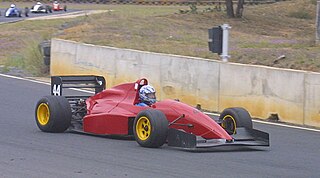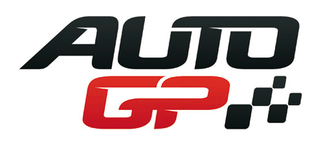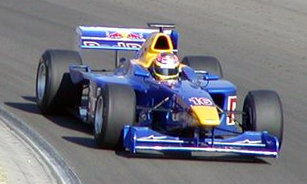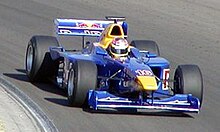
The Formula 3000 International Championship was a motor racing series created by the Fédération Internationale de l'Automobile (FIA) in 1985 to become the final preparatory step for drivers hoping to enter Formula One. Formula Two had become too expensive, and was dominated by works-run cars with factory engines; the hope was that Formula 3000 would offer quicker, cheaper, more open racing. The series began as an open specification, then tyres were standardized from 1986 onwards, followed by engines and chassis in 1996. The series ran annually until 2004, and was replaced in 2005 by the GP2 Series.

Formula Two is a type of open-wheel formula racing category first codified in 1948. It was replaced in 1985 by Formula 3000, but revived by the FIA from 2009–2012 in the form of the FIA Formula Two Championship. The name returned in 2017 when the former GP2 Series became known as the FIA Formula 2 Championship.
Lola Cars International Ltd. was a British race car engineering company in operation from 1958 to 2012. The company was founded by Eric Broadley in Bromley, England, before moving to new premises in Slough, Buckinghamshire and finally Huntingdon, Cambridgeshire, and endured for more than fifty years to become one of the oldest and largest manufacturers of racing cars in the world. Lola Cars started by building small front-engined sports cars, and branched out into Formula Junior cars before diversifying into a wider range of sporting vehicles.
The Japanese Super Formula Championship is a formula racing series held primarily in Japan. It is considered to be the pinnacle of single-seater racing in Japan or Asia as a whole, making it one of the top motorsport series in the region. The series is sanctioned by the Japan Automobile Federation (JAF) and managed by Japan Race Promotion (JRP). As of 2023, Super Formula is the second fastest racing series in the world after Formula One.
Pacific Racing was a motor racing team from the United Kingdom. Following success in lower formulae, the team took part in two full seasons of Formula One, in 1994 and 1995, entering 33 Grands Prix without any success.

Formula racing is any of several forms of open-wheeled single-seater motorsport. The origin of the term lies in the nomenclature that was adopted by the FIA for all of its post-World War II single-seater regulations, or formulae. The best known of these formulae are Formula One, Formula E, Formula Two, Formula Three, regional Formula Three and Formula Four. Common usage of "formula racing" encompasses other single-seater series, including the IndyCar Series and the Super Formula Championship.
The 2005 GP2 Series season was the thirty-ninth season of the second-tier of Formula One feeder championship and also first season under the GP2 Series moniker. The season started in Imola, Italy on 23 April, and ended in Manama, Bahrain on 30 September. The season was won by the German Nico Rosberg, with the Finn Heikki Kovalainen finishing second.

Formula Holden was an Australian open wheel racing category introduced in 1989.
Keith Wiggins is a motor racing team owner born in Great Britain and one of only three people ever to have owned a Formula One team, an IndyCar and a ChampCar team.
The 2006 Formula 3 Euro Series season was the fourth championship year of Europe’s premier Formula Three series. As in previous years, there were ten rounds – each with two races – held at a variety of European circuits. Each weekend consisted of one 60-minute practice session and one qualifying session, followed by one c.110 km race and one c.80 km race. In a revised qualifying system that used only one session, the starting order for race 2 was determined by the finishing order of race 1, with the top eight positions reversed.
The 2005 Formula 3 Euro Series season was the third championship year of Europe's premier Formula Three series. The championship consisted of ten rounds – each with two races – held at a variety of European circuits. Each weekend consisted of one 60-minute practice session and two 30-minute qualifying sessions, followed by one c.110 km race and one c.80 km race. Each qualifying session awarded one bonus point for pole position and each race awarded points for the top eight finishers, with ten points per win. Lewis Hamilton dominated the season, winning 15 of the 20 races and scoring nearly twice as many points as his nearest rival, team-mate Adrian Sutil. As of now, six drivers have competed in Formula One.
The 1990 International Formula 3000 Championship was a motor racing competition organised by the FIA for Formula 3000 cars. It was the sixth running of an FIA Formula 3000 Championship.
The 1993 FIA Formula 3000 International Championship was a motor racing series for Formula 3000 cars. Contested over nine races, it was the ninth FIA Formula 3000 International Championship.

Auto GP, sometimes referred to as the Auto GP World Series and formerly known as both Euro Formula 3000 and the Euroseries 3000, was a European formula racing series.
The British Formula 3000 championship, alternatively known as the British Formula Two Championship, was a competition for Formula 3000 held in the United Kingdom, active from 1989 to 1994 and in 1996. Several attempts to restart the series since then have met with failure.
The Formula Chrysler Euroseries was a single-make open-wheel racing series based in Europe. It ran only in 2001.
Paulo Carcasci is a former Brazilian racing driver. Carcasci won the 1985 European FF 1600 Championship , 1988 BBC FF2000 Championship, 1991 All-Japan Formula Three Championship and the Gold Cup in Formula 3000.
The 1997 British Formula 3000 Championship was the aborted eighth and final season of the British Formula 3000 Championship. Only one meeting on the Brands Hatch Indy circuit went ahead on April 13, where only three cars turned up. The rest of the season was cancelled due to low interest from teams who decided to focus on the International series.

The Lola B02/50 is an open-wheel formula race car chassis developed by British manufacturer Lola, for use in the International Formula 3000 series, a feeder-series for Formula One, from 2002 to 2004, until it was replaced by the new Dallara GP2/05 chassis for the new GP2 Series in 2005.

The Lola B99/50 is an open-wheel formula race car chassis developed by British manufacturer Lola, for use in the International Formula 3000 series, a feeder-series for Formula One, between 1999 and 2001, until it was replaced by the new Lola B02/50 chassis for the new in 2002.









